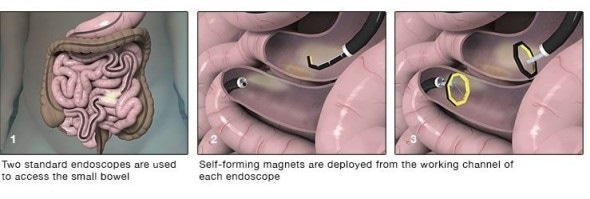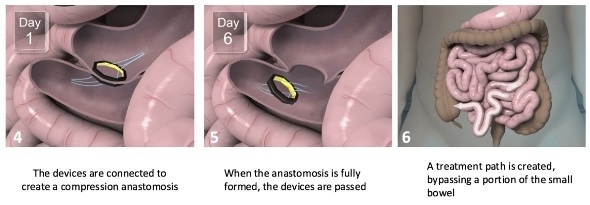May 26 2016
GI Windows, Inc., a clinical-stage medical device company, today announced the presentation of six-month results of the first-ever clinical study evaluating the endoscopic creation of a dual-path enteral diversion using the company’s Incision-less Anastomosis System (IAS) at Digestive Disease Week® 2016 (DDW), in San Diego, Calif. The data support the safety and efficacy of GI Windows’ IAS as a treatment option for Type 2 diabetes in obese patients.

(Photo: Business Wire)
For more than 20 years, studies have confirmed that obese patients with Type 2 diabetes can experience significant and lasting metabolic improvements through bariatric surgeries, such as the gastric bypass. The GI Windows technology enables a non-surgical procedure that can divert a portion of ingested food from the proximal to distal small bowel, providing a less-invasive approach to achieve comparable long-term metabolic benefits as those seen in bariatric surgery.
See Self-assembling Magnets Used to Create The Dual-path Enteral Diversion:
GI Windows Animation
Listen to Christopher C. Thompson, MD, discuss The Dual-path Enteral Diversion at DDW 2016:
DDW 2016_San Diego_Enteral Diversion Procedure_Dr. Chris Thompson
The study reported on the safety and metabolic impact of a dual-path enteral diversion using GI Windows’ Incision-less Anastomosis System. The procedure was performed on 10 obese patients, with a mean body mass index of 41. Four patients had Type 2 diabetes and three more patients were in the pre-diabetic range.
The study found that the dual-path enteral diversion was safely created in all patients, and the IAS devices were expelled without incident. At six months, investigators observed that all patients experienced significant reductions in HbA1c and fasting blood glucose levels. For patients with pre-diabetes, HbA1c levels were reduced from a mean baseline of 6.1 percent to 5.25 percent at six months, and fasting blood glucose levels decreased from 119 mg/dl to 105 mg/dl. Patients with Type 2 diabetes showed a decrease of HbA1c from a mean baseline of 7.8 percent to 6.0 percent at six months, with a decrease in fasting blood glucose levels from 177 mg/dl to 111mg/dl. All patients had fasting blood glucose levels move from the diabetic or pre-diabetic range to the normal range at six months. The mean weight loss for all patients was approximately 28 pounds (12.9 kg), representing a 10.6 percent decrease in total weight loss.
“Type 2 diabetes is a global pandemic and non-surgical treatment options are needed to effectively help the millions of patients manage this chronic condition,” said Evžen Machytka, MD, PhD, Ostrava University Hospital, a study investigator. “The results from this six-month study are promising and suggest that the IAS, which relies on mechanisms of action proven in surgical approaches, has the potential to markedly reduce HbA1c, fasting blood glucose levels, and weight in obese patients with Type 2 diabetes. These findings warrant further investigation of the IAS technology.”
Listen to Evžen Machytka, MD, PhD, about the First in Human Clinical Study at DDW 2016:
The dual-path enteral diversion was created with a flexible endoscope, as smart, magnetic devices are deployed from the scope and self-assemble in the small bowel. The devices transform from a linear shape to an octagonal geometry and then couple to form an anastomosis -- a connection between two hollow or tubular structures or organs. Coupled devices are eventually expelled naturally, leaving behind an anastomosis without residual foreign material. Patients enrolled in the study were restricted to a two-week post-op liquid/soft diet, underwent an upper GI series to confirm anastomotic patency (the degree of openness or exposure) at two weeks post implant, and received follow-up endoscopies at two and six months to visualize the anastomosis.
“Based on this study’s findings, we believe the dual-path enteral diversion, created with the IAS system, may be a viable treatment option for obese patients living with Type 2 diabetes,” said James Wright, President and CEO of GI Windows. “Durability of effect, with non-surgical delivery, is at the core of the GI Windows value proposition. We are pleased with the results we are seeing at 6 months and look forward to presenting 12-month data with the self-assembling magnets in an upcoming publication.”
According to the American Diabetes Association, approximately 30 million children and adults in the United States have diabetes, of which almost 95 percent have Type 2 diabetes. In addition, 86 million U.S. adults are pre-diabetic, according to the Centers for Disease Control and Prevention. Of those with pre-diabetes, 15-30 percent will develop Type 2 diabetes within five years without weight loss and moderate physical activity.